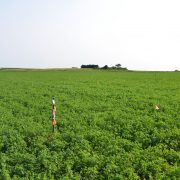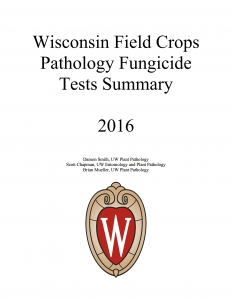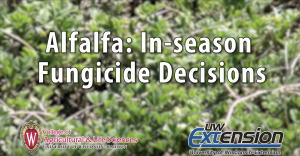What’s the Skinny on Foliar Fungicides for Alfalfa in Wisconsin?
Damon L. Smith, Extension Field Crops Pathologist, Department of Plant Pathology, University of Wisconsin-Madison
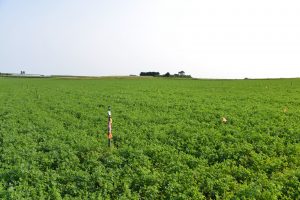
Figure 1. An alfalfa foliar fungicide trial in Arlington, WI.
With high commodity prices this spring and some freeze events affecting alfalfa in Wisconsin several weeks ago, I have been getting many questions about using fungicide on alfalfa. Should you do it? Is it economically viable? Does fungicide help to heal the freeze injury? The answers as you might expect are not always straight forward. Ain’t that just the way…..
What do we know about fungicides?
Before I start into this topic, I’ll mention that you can find more extensive information about fungicides and how they work on the “Field Crops Fungicide Information” page. For all of the products labeled for alfalfa in Wisconsin, they should be applied when the stem have reached a length of 6-8 inches of growth. Applying at this time allows for preventative application (see below) and limits the amount of damage from wheel traffic. In addition, most of these products have at least a 14-day pre-harvest interval. To find information on the fungicides labeled for use in alfalfa in Wisconsin, download A3646-Pest Management in Wisconsin Field Crops.
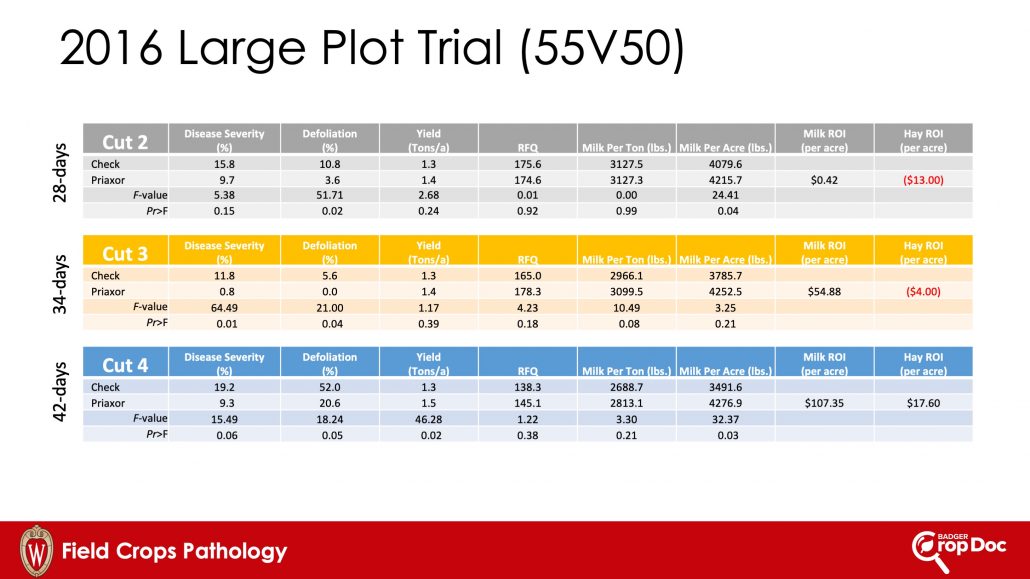
Figure 2. Results of a large-plot foliar fungicide trial on 55V50 alfalfa at the Arlington Agricultural Research Station Located in Arlington, WI in 2016.
Remember that mode of action and mobility in the plant play a big role in how a certain fungicide should be used. As a rule of thumb remember that fungicides should mostly be used as protectants, applied prior to disease development to protect healthy plant tissue. Applying fungicide after extensive disease is observed almost never benefits the plant and is not economically viable. This means that you need to anticipate when disease might show up. In alfalfa, there are numerous foliar diseases that can affect the crop during the season, including common leaf spot, Letosphaerulina leaf spot, and Stemphylium leaf spot to name just a few. Most of these leaf spots are promoted by wet weather. Keeping good history of the diseases you have seen in the past on your farm, and tracking weather events (especially those where the weather is wetter than average) can help you anticipate the onset of these diseases. In alfalfa, we also must consider what our target cutting-duration is to be. We know from our more recent research (Figure 2) that cutting duration plays a significant role in the success of fungicide applications on alfalfa. If cutting duration is to be longer than 28-30 days, then the likelihood of an economic return is higher when fungicide is used. If the intent is to continue to cut using a shorter duration of 25-30 days, then the likelihood goes down in achieving an economic return when applying fungicide. Regardless of cutting duration, weather can also influence success. Abnormally wet weather can push pathogens faster. Dryer weather may mean that no fungicide is needed as the pathogen can’t increase as readily. So, pay attention to the rainfall as you make the decision to apply.
Why does cutting duration impact economic return when using fungicide on alfalfa?
Well, it simply comes down to the biology and epidemiology of the pathogens that affect the foliage of alfalfa. These pathogens don’t show up until about 14-21 days after cutting (or greenup). It takes them time to appear and start to get to a level that they cause the plant to defoliate. In the 1990s Duthie and Campbell reported that longer durations of cut between alfalfa crops allowed the pathogens to grow to levels that were more likely to be damaging. If we cut on shorter durations, we are physically removing the pathogen with the plant material during harvest, prior to when significant defoliation would happen. The application of fungicide in this scenario has little effect, because the pathogen was not causing any damage. Compare this to longer durations of cut, where the pathogens can rise to levels where they might cause defoliation. The application of fungicide in this scenario has a higher likelihood of success as it can slow the pathogen down and limit defoliation. Figure 2 shows data from 2016 in large alfalfa plots, where we gradually increased the duration of cut. Notice as the duration increased there was a corresponding increase in the return on investment (ROI) either as dry hay or in milk production.
Does fungicide help to heal freeze injury?
The short answer is no. Fungicides work to prevent and deter fungi. They work as primarily protectants on the plant and do not facilitate any healing of the plant. Can they protect an open injury from a pathogen? Perhaps, but data are weak at best, with this being a viable tactic. Thus, if you plan to use fungicide as a foliar application on alfalfa, make sure your target is indeed a foliar fungus.
Does alfalfa variety affect success when using a fungicide?
Directly, variety can play a small role in success with fungicides. Some varieties can be more susceptible to certain pathogens. However, the modern varieties I have looked at in recent years tend to respond similarly to these various foliar pathogens, with decent levels of partial resistance. We don’t see much separation in fungicide product on the various varieties.
The one caveat to consider though is if you are using reduced- or low-lignin varieties. If this is the case and your intent is to widen the cutting duration (longer than 30 days) then the likelihood of economic success when using a fungicide goes up. Note however, that this phenomenon is the same even if you are using a longer cutting duration on a conventional variety. Remember, cutting duration is really the important driver here.
Does fungicide product impact ROI on alfalfa?
Not really. You can find results from fungicide efficacy trials in Wisconsin on the “Wisconsin Fungicide Tests Summaries” page. Most of the fungicides labeled for alfalfa in Wisconsin have decent efficacy toward the major pathogen we run into. So, it simply comes down to that cutting duration again and what your best deal is on price for the fungicide of interest. Obviously, the lower that the fungicide cost is, the higher the ROI could be. But remember to get the timing of application correct and try to anticipate those potentially longer durations of cut.
Is the first crop the crop with the most potential for success when using foliar fungicide?
Perhaps. It makes the most sense. This crop has the highest yield potential and likely will sit out there the longest, exposed to pathogens and experiencing rain events. However, when we looked at this scientifically in some of our older work, the odds of success with a foliar fungicide are equal on all crops. What this means is that using foliar fungicide on any of the cuttings during the season could result in success. It simply comes down to that cutting duration and if the weather is wet enough to allow the pathogen to reach levels that cause defoliation on the plants, prior to harvest.
The Take-Home
In alfalfa, application of fungicide should be reserved when the risk of foliar disease is high. Wet weather leading to increased durations between cuttings can lead to higher risk of disease and warrant application of fungicides. Dry weather or short durations between cutting intervals lead to low risk of foliar disease development. Fungicides are not warranted under these conditions and quality is not readily affected by fungicide applications under short cutting durations.

